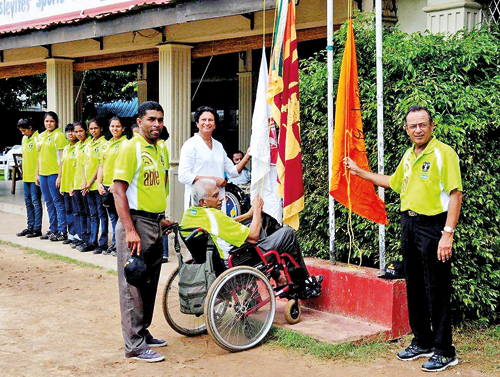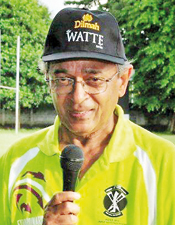Long, fulfilling journey with Colombo Friend in Need Society
To understand why and how I became a life member, member of the Board of Management and later Vice President of this 190-year-old charitable organization, I need to explain in brief my beginnings as a surgeon and my interest in artificial limbs.In 1969, as a lecturer in surgery at the Colombo Medical Faculty, I opted for specializing in vascular surgery in the UK which was mainly involved with reconstructing and restoring blood flow to limbs and organs thereby preventing gangrene, which if present necessitates amputation.

Prof Sheriffdeen (right) at an event organised by CFINS
In 1970, I returned to Ceylon (Sri Lanka), qualified, well trained and fuelled with enthusiasm. However, I was appalled to note that awareness of this specialty was woefully inadequate amongst doctors. Blood flow to limbs gets interrupted when arteries supplying blood to limbs get narrowed or blocked often due to atherosclerosis. Sudden interruption to blood flow occurs when arteries are blocked by clots released from the heart or when arteries are damaged after trauma – traffic accidents, violence with swords or sharp instruments, or trap gun injuries. In this situation emergency surgery has to be performed within 6 to 8 hours or gangrene would set in and amputation would be the outcome.
Soon enough patients were referred to me from all parts of the country, and I was kept busy most days and nights attending to them. The civil war which started around 1983, the bomb blasts and gunshot/ artillery and mortar injuries added to this serviceable work and kept me burning the midnight oil on many days. Unfortunately, a fair number of patients who were not sent to us within the 6 to 8-hour salvageable period were victims of gangrene and had to undergo amputation to save their lives. These amputees needed artificial limbs (prosthesis) for their rehabilitation. The Orthopedic Clinic at the General Hospital, Colombo, now the National Hospital of Sri Lanka, had a prosthetic workshop and turned out two limbs a month. They were hampered by non-availability of materials in those days of austerity.
I was looking for an institution or organization which would help my patients, manufacture prostheses faster and at an affordable rate. A junior doctor told me that a Professor P.K.Sethi, from Jaipur, India, had won a Guinness Award for Scientific Achievement for inventing a low cost foot piece and prosthesis suitable for barefoot users and for walking on uneven terrain. I was also told that the Colombo Friend in Need Society (CFINS) was preparing to send staff to Jaipur for training with the intention of setting up local workshops to manufacture these prostheses.

Prof Sheriffdeen
I found the organization on an early Saturday morning in February 1985 and came face-to-face with a lady seated at a desk deep in thought. Upon introduction she jumped up with arms outstretched remarking “my prayers have been answered!” Her account of our encounter in the 1990, 5th Anniversary issue reads as follows: “February 1985: Dr. A.H. Sheriffdeen of the Faculty of Medicine – University of Colombo walked in one Saturday morning when Mrs. Swarna Ferdinand was watching the Workshop building coming up. He introduced himself to her and said ‘My services are available to you. There is a great need for a low cost artificial lower limb and I will help you in any way possible’. That was the first spontaneous offer received from a surgeon and it brought in confidence that this work was going to win the support of other world-class eminent surgeons too like him”.
She continues, “Mrs. Ferdinand says that Professor Sethi had warned her ‘Be prepared for opposition from Western qualified medical men- maybe this technology demystifies their work’. It did happen in India. We are proud to record that the majority of Western qualified medical personnel, the most eminent surgeons and Doctors, psychologists, physiotherapists etc. welcomed the advent of a low cost artificial limb, easy and quick to turn out with locally available raw materials, by simple local craftsmen. Many of them told us what a difference it was to be able to say to a person before amputation, ‘Don’t worry, in a couple of months you’ll be back on your two feet with a Jaipur limb’.”
Over time the programme took off to a flying start under the powerhouse that was the late Mrs. Swarna Ferdinand, Project Manager, Jaipur Foot Programme and Hon. Secretary, CFINS, Ms. Jeanne Samuel, Assistant Project Manager, Jaipur Foot programme, and the energetic Production Manager, Laksiri Mellawa.With branches set up in Galle, Kandy and Jaffna this energy has sustained the programme over the last 36 years.
Many notable personalities and eminent medical professionals have dedicated their time and effort to the continuation of this society. A notable person was Nihal Abeysekera, the Executive Director of Arpico Factory, Nawinna, representing Richard Peiris & Co. Ltd. In 2016 he took over as President of the Society, refurbished the premises and was forever looking for ways and means of improving the services and the prosthesis. His experience with the rubber and adhesives industry also helped the foot piece production area. This resulted in him starting up the 3D printing project to produce limbs in the Society.
A rehabilitation programme should offer besides physical support, further support in the form of recreation, income generating activity support and counselling and psychological support. The society has held a Sports Festival for Jaipur Limb users as part of their rehabilitation therapy. Additionally in 1988, with the assistance of World Vision, a self-employment scheme was inaugurated to give financial assistance to amputees.
Around 2002 I had drawn up an ambitious scheme centred on rehabilitating low-income Jaipur limb users with assistance with self-employment projects. I appealed to various institutions for support but my only response was from Ken Balendra, who persuaded the business institution of which he was Chairman to donate Rs. 2 million as part of their CSR activities. We have also been generously supported by the MJF Charitable Foundation which organisation also gives a monthly allowance to schoolchildren using the Jaipur limb.
The Colombo Friend in Need Society has indeed come a long way. We have two orthopedic surgeons in the Board, Dr. Swarnakumar and Dr Upali Banagala. Professor Ajith Malalasekera from the Faculty of Medicine Colombo has teamed up with the Department of Psycho-social Medicine and the School of Prosthetics and Orthotics to give a better service. He is ably assisted by a graduate Prosthetics and Orthotics officer and a qualified physiotherapist. They are backed by a dedicated set of Board members given able leadership by our current president Supem de Silva who has taken over the challenge of running the society in the face of COVID-19 with the closure of the hostel and diminishing income whilst being assisted by the ever-popular Secretary, Dr. Ranjan Dias. I am happy to note that the future of the society is in safe hands.
I end quoting Professor Sethi’s letter sent to us in 1990, on the 5th anniversary celebrations of the launch of the Jaipur Foot programme. He stated “The Jaipur Foot programme launched by the Colombo Friend in Need Society has exceeded my wildest dreams.To win over a traditionally orthodox medical profession, to involve the country emotionally into every aspect of amputee rehabilitation, to set up a network of limb fitting centres in the major towns of your country and change the grim prospects an amputee faced when I went to Sri Lanka in 1983 into a much more hopeful future, and more importantly, to create a second line of dedicated leadership who are inheritors of the value-system so central to the concept of ‘Jaipur Foot’, is indeed a remarkable achievement by any standards.”



